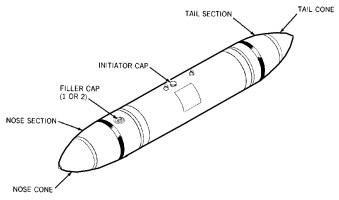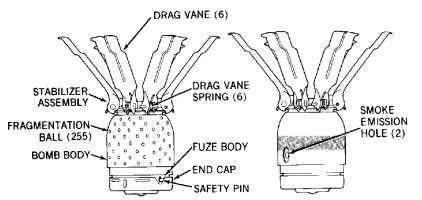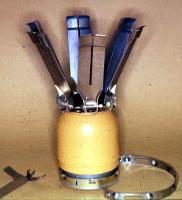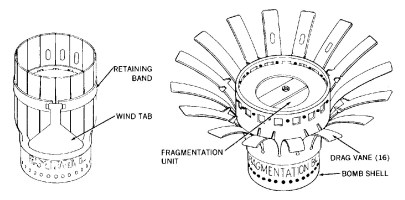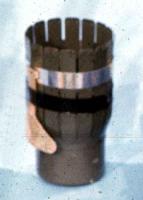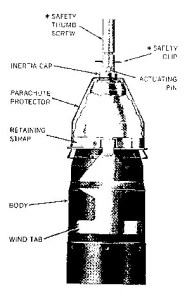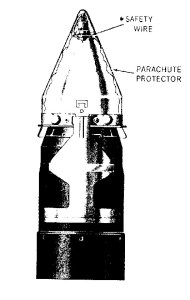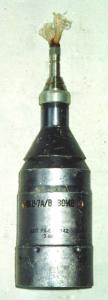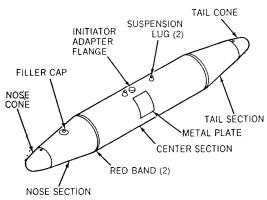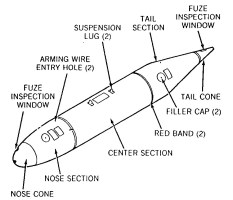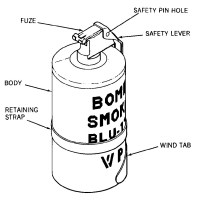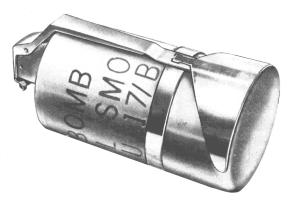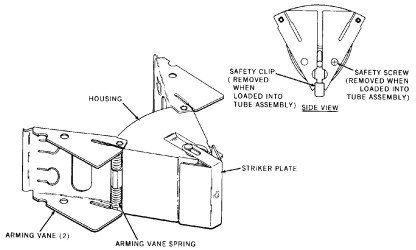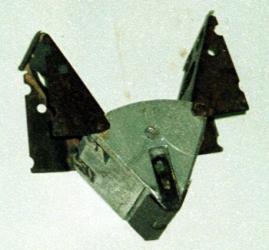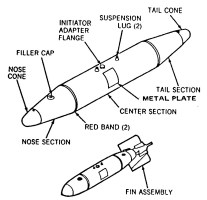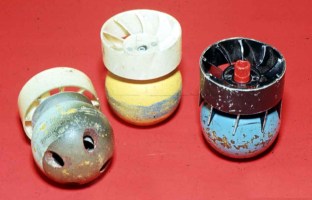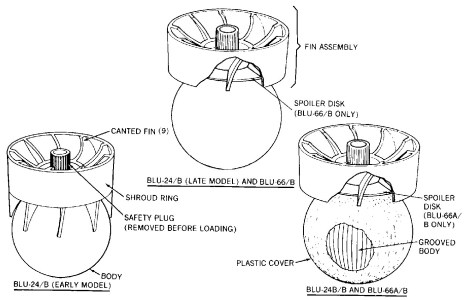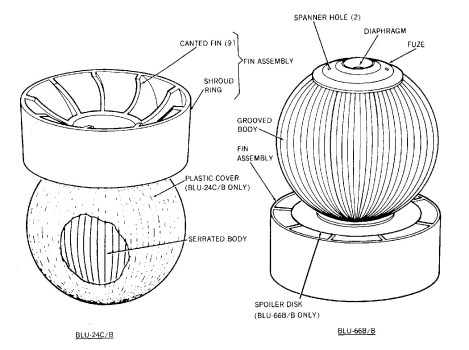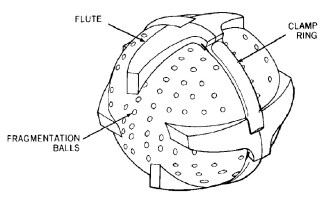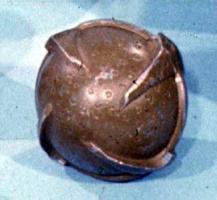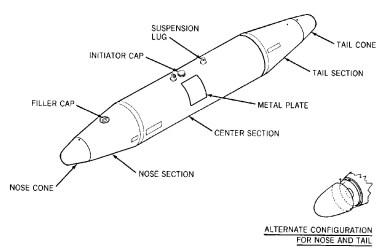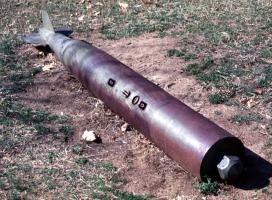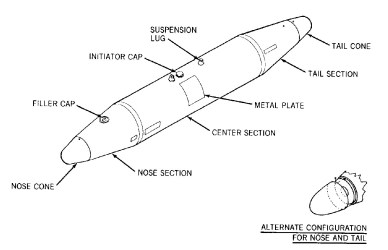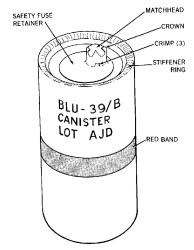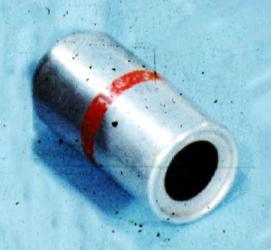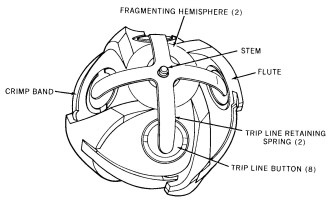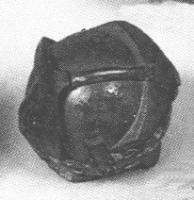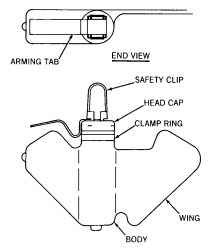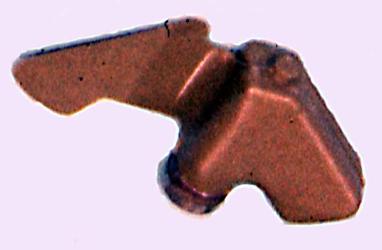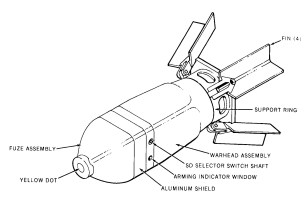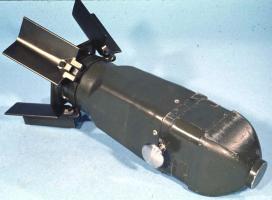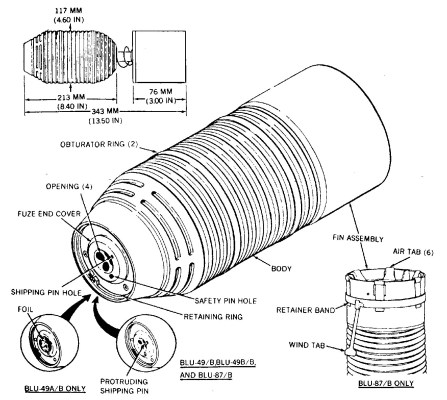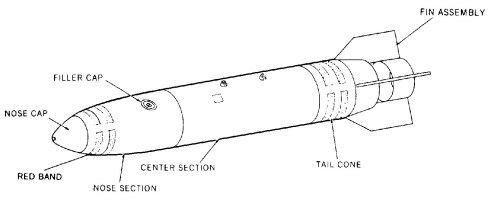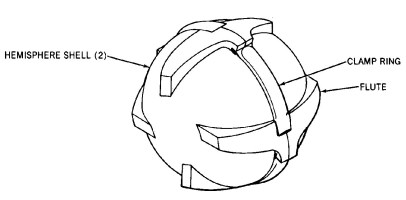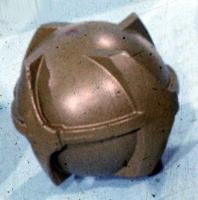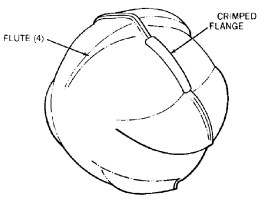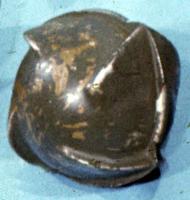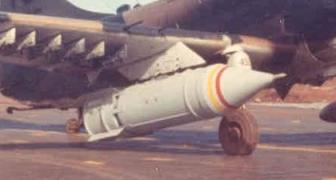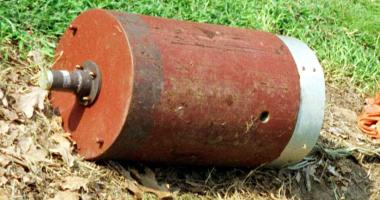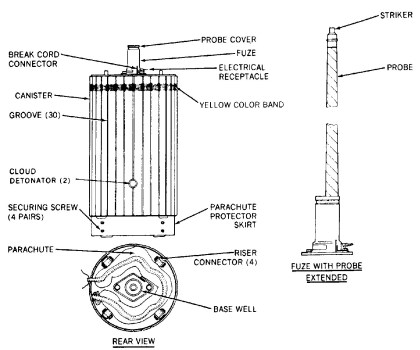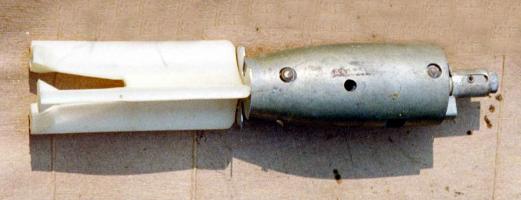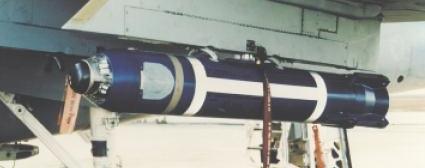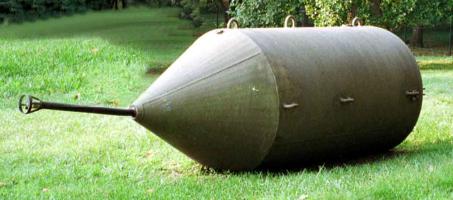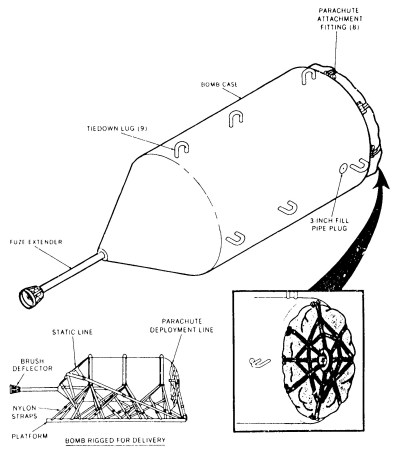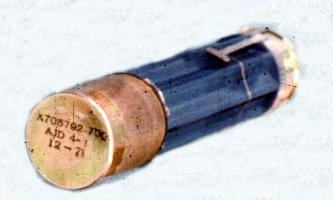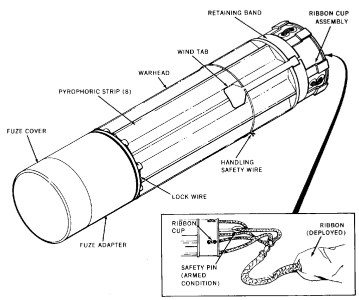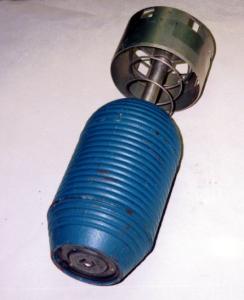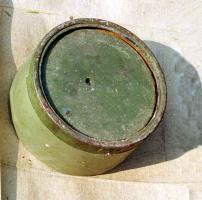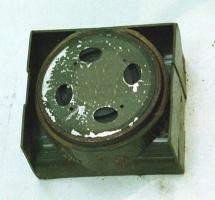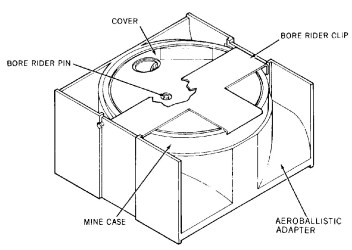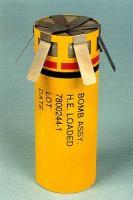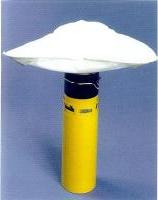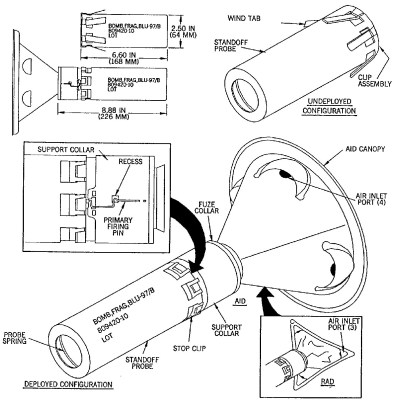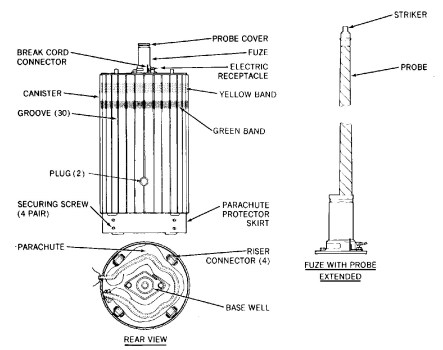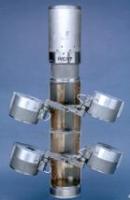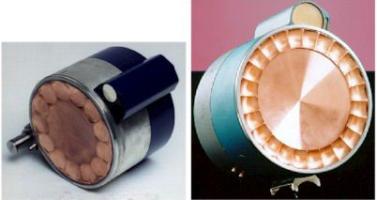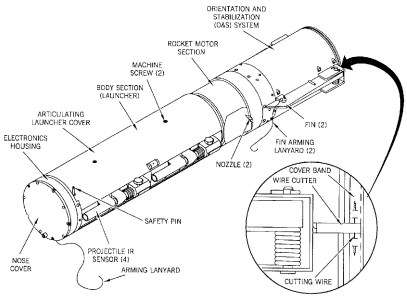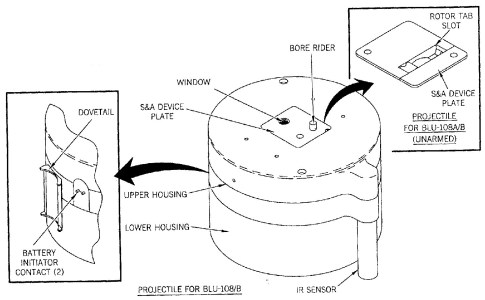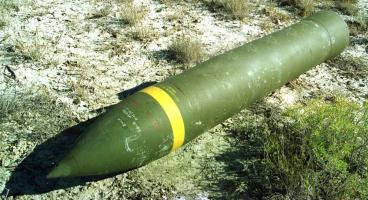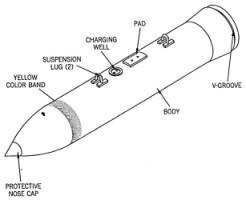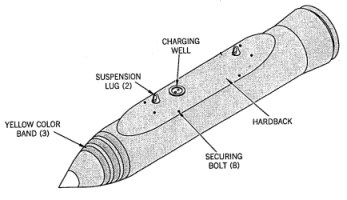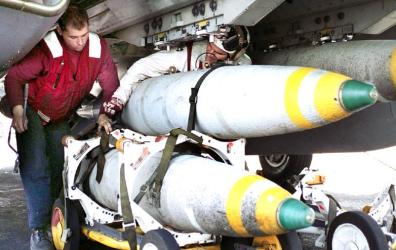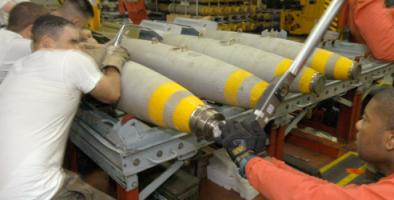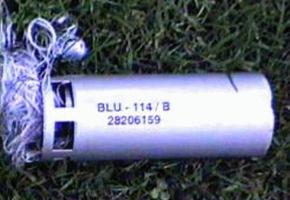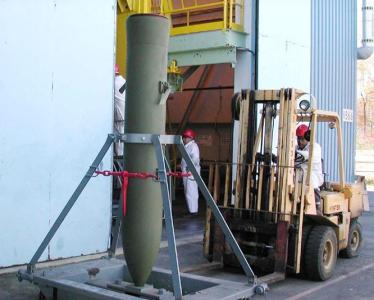BAK to BSU/BSG - Equipment Listing
Copyright © 2001-2024 Andreas Parsch
[AxU] [BxU] [CxU] [DxU] [ExU] [FxU] [GxU] [HxU] [JxU] [KxU] [LxU] [MxU] [NxU] [PxU] [RxU] [SxU] [TxU] [VxU] [WxU]
Index of ASETDS Designation Listings
BAK - Aircraft Arresting System ComponentsBBU - Explosive Items
BCU - Battery Chargers
BDU - Simulated Bombs
BGU - Bags
BLU - Bombs
BNU - Buoys
BRU/BRK - Bomb Racks and Shackles
BSU/BSG - Munitions Stabilizing and Retarding Devices
BAK - Aircraft Arresting System Components
| (1...5) | (No information) |
| BAK-6/F27A | |
| BAK-7/F32A | Aircraft Arresting Barrier |
| (8) | (No information) |
| BAK-9/F48A | Emergency Aircraft Arresting Barrier |
| (10) | (No information) |
| BAK-11/F | Aircraft Arresting Barrier Engaging Device |
| BAK-12/E32A | Rotary Friction Portable Aircraft Arresting System |
| BAK-13/F48A | Aircraft Arresting System |
| BAK-14/F | Retractable Hook Cable Support System for Aircraft Arresting Systems; used with BAK-12/E32A, BAK-13/F48A |
| BAK-15/E | Net-Type Aircraft Arresting Barrier |
BBU - Explosive Items
| (1...14) | (No information) |
| BBU-15/B | Fuze Booster; used with FMU-90/B |
| (16...17) | (No information) |
| BBU-18/B | Propellant Actuated Gas Pressure Generator |
| (19...22) | (No information) |
| BBU-23/B | Fuze Booster |
| (24...34) | (No information) |
| BBU-35/B | Impulse Cartridge; used with MJU-48/B, MJU-51/B, RR-170/AL |
| BBU-36/B | Impulse Cartridge; used with MJU-7/B, MJU-10/B, MJU-40/B, MJU-47/B, MJU-53/B |
| (37...39) | (No information) |
| BBU-40/B | Guided Missile Warhead Booster |
| (41...42) | (No information) |
| BBU-43/A | Electric Detonator |
| (44...45) | (No information) |
| BBU-46/B | Impulse Cartridge; used with MJU-23/B flare in AN/ALE-49 |
| BBU-47/B | Fuze Booster; used with FMU-148/B |
| BBU-48/B | Impulse Cartridge; used with RR-180/AL chaff |
| (49...51) | (No information) |
| BBU-52/B | Impulse Cartridge; used in AN/ALE-50 |
| (53...54) | (No information) |
| BBU-55/B | Explosive Bolt |
| (56) | (No information) |
| BBU-57/A | Cutter Assembly |
| (58) | (No information) |
| BBU-59/B | Impulse Cartridge; used with MJU-39/B in AN/ALE-52 |
| BBU-60/B | Fuze Booster; used with FMU-155/B |
| (61...62) | (No information) |
| BBU-63/B | Impulse Cartridge; used with BRU-44/A |
| BBU-64/A | Cutter Assembly |
| (65...68) | (No information) |
| BBU-69/B | Fuze Booster |
BCU/BCK - Battery Chargers
| BCU-1/E | |
| (2) | (No information) |
| BCU-3/M | |
| BCU-4/E | Battery Charger |
| BCU-5/M | |
| BCU-6/E | Battery Charger |
| (7) | (No information) |
| BCU-8/E | |
| (9...10) | (No information) |
| BCU-11/E | |
| BCU-12/E | Battery Charger |
| BCU-13/E | Battery Charging and Stowage Cabinet |
| (14) | (No information) |
| BCU-15/E | Battery Charger |
| (16...18) | (No information) |
| BCU-19/E | Battery Charger |
| BCU-20/E | Battery Charger/Analyzer |
| BCU-21/E | Lead Acid Battery Charger/Discharger |
| (22...25) | (No information) |
| BCU-26/A | Battery Charger |
| BCK-27/A24A-55 | Battery Charger |
BDU - Simulated Bombs
| (1) | (No information) |
| BDU-2/B | 10 lb Practice Bomb; used for MK-28RE nuclear bomb training |
| BDU-3/B | 2000 lb Practice Bomb; used for MK-28IN nuclear bomb training |
| BDU-4/B | Practice Bomb; used for MK-28RE nuclear bomb training |
| (5) | (No information) |
| BDU-6/E | Loading Practice Bomb for B43 nuclear bomb |
| BDU-7/E | Loading Practice Bomb for TX-46 nuclear bomb (cancelled) |
| BDU-8/B |
Practice Bomb; used for B43 nuclear bomb training Variants: - BDU-8/B - BDU-8A/B: Utilizes an aircraft pullout cable containing an inplug simulator |
| BDU-9/E | Loading Practice Bomb; used for MK-53 nuclear bomb training |
| BDU-10/E | Loading Practice Bomb; used for MK-28EX nuclear bomb training |
| BDU-11/E | Loading Practice Bomb; used for B57 nuclear bomb training |
| BDU-12/B |
Practice Bomb; used for B57 nuclear bomb training Variants: - BDU-12/B - BDU-12A/B |
| BDU-13/B | Practice Bomb; used for MK-53 nuclear bomb training |
| BDU-14/E | Loading Practice Bomb; used for MK-28RE nuclear bomb training |
| BDU-15/E | Loading Practice Bomb; used for MK-28RE nuclear bomb training |
| BDU-16/E | Loading Practice Bomb; used for MK-28RI/FI nuclear bomb training |
| BDU-17/B | Practice Bomb |
| BDU-18/B | Practice Bomb; used for B43 nuclear bomb training |
| BDU-19/B | Practice Bomb; used for B57 nuclear bomb training |
| BDU-20/C |
Practice Bomb; used for B57 nuclear bomb training Variants: - BDU-20/C - BDU-20A/C - BDU-20B/C - BDU-20C/C |
| BDU-21/B | Practice Bomb |
| (22) | (No information) |
| BDU-23/B | 25 lb Practice Bomb |
| BDU-24/C | Practice Bomb; used for B43 nuclear bomb training |
| BDU-25/B | Practice Bomblet; used for BLU-7/B delivery training |
| BDU-26/E | Loading Practice Bomb; used for MK-28EX nuclear bomb training |
| BDU-27/B | Spotting Charge (variant of BLU-3/B); used in CBU-8/A (409 BDU-27/B in SUU-7A/A) |
| BDU-28/B |
Dummy Fragmentation Bomb (variant of BLU-3/B); used in - CBU-9/A (406 BDU-28/B in SUU-7A/A) - CBU-9A/A (406 BDU-28/B in SUU-7B/A) |
| BDU-29/E | Loading Practice Bomb; used for MK-28RE nuclear bomb training |
| BDU-30/B | Practice Bomb |
| (31) | (No information) |
| BDU-32/E | Loading Practice Bomb; used for B57 nuclear bomb training |
| BDU-33/B |
25 lb Practice Bomb; used for MK 82 bomb training Variants: - BDU-33/B - BDU-33A/B - BDU-33B/B - BDU-33D/B |
| BDU-34/B | Practice Bomb |
| BDU-35/E | Loading Practice Bomb; used for B43 nuclear bomb training |
| BDU-36/C | Practice Bomb; used for B61 nuclear bomb training |
| BDU-37/B | Practice Bomb |
| BDU-38/B | Practice Bomb; used for B61 nuclear bomb training |
| BDU-39/B | Practice Bomb; used for B61 nuclear bomb training |
| BDU-40/B | Practice Bomb |
| BDU-41/B | Practice Bomb |
| (42) | (No information) |
| BDU-43/B | Inert General Purpose Bomb |
| (44) | (No information) |
| BDU-45/B | 500 lb Inert Practice Bomb; used for MK 82 bomb training |
| BDU-46/E | 91 lb Practice Bomb; used for B61 nuclear bomb training |
| (47) | (No information) |
| BDU-48/B | 10 lb Practice Bomb |
| (49) | (No information) |
| BDU-50/B |
500 lb Practice Bomb; used for MK 82 bomb training Variants: - BDU-50/B - BDU-50A/B - BDU-50B/B - BDU-50C/B |
| (51...52) | (No information) |
| BDU-53/B | Practice Bomb; used for B90 nuclear bomb training |
| BDU-54/B | 1000 lb Practice Bomb; used for MK 83 bomb training |
| BDU-55 | |
| BDU-56/B | 2000 lb Practice Bomb; used for MK 84 bomb training |
| BDU-57/B | LGTR (Laser Guided Training Round); used for "Paveway II" LGB training |
| (58) | (No information) |
| BDU-59/B |
LGTR (Laser Guided Training Round); used for "Paveway II" LGB training Variants: - BDU-59/B - BDU-59A/B - BDU-59B/B |
| BDU-60/B |
LGTR (Laser Guided Training Round) II; used for "Paveway II" LGB training Variants: - BDU-60/B - BDU-60A/B |
| BDU-61/B | 1000 lb Practice Bomb |
BGU - Bags
| BGU-1/P | Navigator's Briefcase |
BLU - Bombs
Notes about extended BLU listing:
- Physical characteristics data given by several sources often show slight variations. Figures given below may therefore be inaccurate. This is especially true for the weight figures!
- The information in this section was extracted from a multitude of sources. The most important are:
- Christopher Chant: "World Encyclopaedia of Modern Air Weapons", Patrick Stephens Ltd., 1988
- ORDATA Online Website
- U.S. military and government websites
- "Jane's Weapon Systems" (various editions)
| BLU-1/B |
The BLU-1/B was a 340 kg (750 lb) class fire bomb, filled with about 340-380 liters (90-100 US gal) of napalm. Other than the BLU-1/B, which was filled in the field, the BLU-1B/B was filled in the factory. There was also a BLU-1C/B version, for which no details are available. The BLU-27( )/B series was similar to the BLU-1( )/B, but was filled with the heavier Napalm-B mixture.
Data for BLU-1/B:
|
||||||||||||||||||
| BLU-2/B |
The BLU-2/B was the TCP (Two Component Pod) combined weapon/fuel pod used by the B-58A Hustler. It consisted of two separate pods (one above the other), the upper being semi-recessed in the lower one. The upper component (BLU-2/B-1) contained two fuel compartments and the Mk.53 thermonuclear warhead, while the lower component (BLU-2/B-2) contained only fuel. The BLU-2/B-1 also included the pylon for attachment to the aircraft, three tailfins, and a parachute retarder system. The lower BLU-2/B-2 could be jettisoned separately from the upper part.
Data for BLU-2/B-1:
Data for BLU-2/B-2: |
||||||||||||||||||
| BLU-3/B |
The BLU-3/B "Pineapple" was a fragmentation bomblet for use against personnel and unarmoured targets. After release from the aerial dispenser, the bomblet was stabilized by six pop-out drag vanes. It detonated on impact, and dispersed 250 high-velocity steel pellets. The BDU-27/B was a black powder filled spotting charge, which was externally almost identical to the BLU-3/B. The BLU-3/B was used as payload in the following cluster bombs:
Data for BLU-3/B:
|
||||||||||||||||||
| BLU-4/B |
The BLU-4/B was an anti-personnel fragmentation bomblet. After release from the aerial dispenser, 16 drag vanes opened to stabilze the bomb's fall. On ground impact, an hemispherical fragmentation unit was ejected upwards, and exploded at a height of about 3 m (10 ft). The BLU-4A/B variant had a foil tape at the top of the bomblet. The BLU-4( )/B was used as payload in the following cluster bombs:
Data for BLU-4/B:
|
||||||||||||||||||
| (5) | (No information) | ||||||||||||||||||
| BLU-6/B | The BLU-6/B was a spherical smoke bomblet, which had a TMU-10/A airborne smoke generator as payload. | ||||||||||||||||||
| BLU-7/B |
The BLU-7/B was a shaped-charge anti-material/anti-tank bomblet. It was armed and stabilized by parachute, and detonated on impact. The BLU-7A/B variant had a redesigned nose assembly (with safety, arming and parachute components). The BLU-7( )/B was used as payload in the following cluster bombs:
Data for BLU-7/B and -7A/B:
|
||||||||||||||||||
| (8...9) | (No information) | ||||||||||||||||||
| BLU-10/B |
The BLU-10/B was an unstabilized 113 kg (250 lb) class fire bomb filled with 125 liters (33 US gal) of napalm. The bomb was filled in the field. There was also a BLU-10A/B variant, possibly a factory-filled version.
Data for BLU-10/B:
|
||||||||||||||||||
| BLU-11/B |
The BLU-11/B was a 225 kg (500 lb) class fire bomb filled with 245 liters (65 US gal) of napalm.
Data for BLU-11/B:
|
||||||||||||||||||
| (12...13) | (No information) | ||||||||||||||||||
| BLU-14/B |
The BLU-14/B was a 347 kg (766 lb) ground-penetrating anti-vehicle mine for release by low-flying (down to 11 m (35 ft) altitude) aircraft. It was a derivative of the MLU-10/B mine, and therefore essentially identical in shape and weight to the BLU-31/B. |
||||||||||||||||||
| BLU-15/B | The BLU-15/B was an anti-material bomb containing balls of hardened steel or other alloys. It was tested in the 1963/64 time frame. | ||||||||||||||||||
| BLU-16/B |
The BLU-16/B was a 0.73 kg (1.6 lb) smoke bomblet (a modified M8 smoke grenade). Its external dimensions were presumably close to those of the BLU-17/B, because it was interchangeable with the latter in the SUU-7B/A dispenser. The BLU-16/B was used as payload in the following cluster bombs: |
||||||||||||||||||
| BLU-17/B |
The BLU-17/B was a 0.5 kg (1.1 lb) WP (white phosphorus) smoke bomblet (a modified M15 smoke grenade). The BLU-17/B was used as payload in the following cluster bombs:
Data for BLU-17/B:
|
||||||||||||||||||
| BLU-18/B |
The BLU-18/B was a dispenser-delivered anti-personnel fragmentation bomblet. It had two spring-loaded arming vanes, which extended after release from the dispenser. The bomblet rebounded after impact, and the impact-armed delay fuze therefore resulted in an air burst slightly above ground. The BLU-18/B was used as payload in the following cluster bombs:
Data for BLU-18/B:
|
||||||||||||||||||
| BLU-19/B23 | The BLU-19/B23 was a chemical warfare bomblet containing the lethal GB (Sarin) nerve agent. It was dispensed by the CBU-15/A cluster bomb, which consisted of an unknown number of BLU-19/B23 bomblets in an SUU-13/A dispenser. | ||||||||||||||||||
| BLU-20/B23 | The BLU-20/B23 was a chemical warfare bomblet containing the non-lethal BZ hallucinogen (for use as an incapacitant agent). It was probably similar in size and shape to the BLU-19/B23 GB bomblet. The BLU-20/B23 was dispensed by the CBU-16/A cluster bomb, which consisted of 40 CDU-9/B clusters with an unknown number of BLU-20/B23 bomblets in an SUU-13/A dispenser (or SUU-13A/A in the CBU-16A/A version). However, the effects of BZ turned out to be too unpredictable for use as a weapon, and therefore the substance (and any munitions containing it) were abandoned | ||||||||||||||||||
| BLU-21/B45 BLU-22/B45 |
The BLU-21/B45 and BLU-22/B45 were biological warfare bomblets containing a dry (BLU-21) and liquid (BLU-22) biological agent, respectively. These bomblets were developed and tested in the 1966/67 time frame, but any details remain classified. | ||||||||||||||||||
| BLU-23/B |
The BLU-23/B was an unstabilized 225 kg (500 lb) class fire bomb filled with 254 liters (67 US gal) of Napalm-B (a slightly heavier development of the original napalm). The bomb was filled in the field, and could be fitted with alternate nose and tail cones, as well as an optional tailfin kit. The BLU-32( )/B series of bombs was very similar, but apparently filled with still heavier mixtures of Napalm-B.
Data for BLU-23/B:
|
||||||||||||||||||
| BLU-24/B |
The BLU-24/B "Orange" was a small air-dispensed anti-personnel fragmentation bomblet. It was centrifugally armed (by the spin induced after release from the dispenser) and fired when the spin decayed below a certain threshold. When dropped over dense jungle arreas, this arming and firing sequence ensured that the bomblets would detonate between the forest canopy and the ground. The BLU-24/B had a spherical body with 300 embedded steel fragments, a shroud ring, and nine canted fins to induce a spin. On early BLU-24/Bs the fins extended below the shroud, but later examples had shorter fins. The BLU-24B/B variant had a grooved fragmentation body, which was covered by plastic to prevent adverse aerodynamic effects of the grooves. While the BLU-24/B and -24B/B bomblets were optimized for use in a jungle environment, the BLU-24C/B was a BLU-24B/B derivative for all-terrain use. The BLU-66( )/B series was a derivative of the BLU-24( )/B for delivery by high-speed aircraft.
The BLU-24( )/B was used as payload in the following cluster bombs:
It can be assumed that the CBU-25( )/A, -46/A and/or -60/A could also be filled with BLU-24B/B and/or -24C/B bomblets.
Data for BLU-24/B and -24B/B:
|
||||||||||||||||||
| BLU-25/B | The BLU-25/B was a cylindrical anti-personnel bomblet. It was used as the payload of the CBU-18/A cluster bomb (BLU-25/B in SUU-13A/A). | ||||||||||||||||||
| BLU-26/B |
The BLU-26/B "Guava" was an air-dispensed APAM (anti-personnel/anti-material) fragmentation bomblet with 600 embedded steel fragments. The BLU-26/B had three different fuzing options. It could detonate immediately on impact, as an airburst 9 m (30 ft) above ground, or after a selectable but fixed time after impact. The externally identical BLU-36/B and BLU-59/B had random-delay fuzes. The BLU-26/B was used as payload in the following cluster bombs:
In 1966/67, the BLU-26/B bomblet was also evaluated as a payload for the AGM-12C Bullpup guided missile. These tests probably led to the development of the AGM-12E variant, which had an anti-personnel cluster bomb warhead using BLU-26/B bomblets.
Data for BLU-26/B:
|
||||||||||||||||||
| BLU-27/B |
The BLU-27( )/B series of 340 kg (750 lb) class fire bombs was very similar to the BLU-1( )/B, but was filled with Napalm-B, a heavier derivative of the basic napalm. The BLU-27/B could be fitted with alternate nose and tail cones, and probably also with an optional tailfin kit. There were also BLU-27A/B, BLU-27B/B and BLU-27C/B versions, but no information about the differences is available.
Data for BLU-27/B:
|
||||||||||||||||||
| BLU-28/B | The BLU-28/B (sometimes referred to as BLU-28/B45) was a biological warfare bomblet containing a self-dispersing biological agent (further details unavailable and most likely classified). The names "Prism" and "Triangular Rotor Bomblet" have been connected to this munition. | ||||||||||||||||||
| BLU-29/B | The BLU-29/B was a 73 kg (160 lb) anti-personnel/anti-material incendiary bomb, which used a flame agent canister. | ||||||||||||||||||
| BLU-30/B | The BLU-30/B was a chemical warfare bomblet, which contained the non-lethal BZ hallucinogen for use as an incapacitant agent. The effects of BZ turned out to be too unpredictable for use as a weapon, and therefore the substance (and any munitions containing it) were abandoned. | ||||||||||||||||||
| BLU-31/B |
The BLU-31/B was a 340 kg (750 lb) class anti-vehicle demolition mine and bomb. It was a derivative of the MLU-10/B mine with new acoustic and seismic sensors, tuned to the sound and vibration of tanks. If not triggered, the BLU-31/B self-destructed after 83 hours.
Data for BLU-31/B:
|
||||||||||||||||||
| BLU-32/B |
The BLU-32( )/B series of 225 kg (500 lb) class fire bombs was externally almost identical to the BLU-23/B, but was presumably filled with a heavier version of Napalm-B (because of the quoted higher mass in the same volume as the BLU-23/B). Like the BLU-23/B, the BLU-32( )/B series could also be fitted with alternate nose and tail cones and optional tailfins. The BLU-32A/B was about 30 kg (66 lb) heavier than the basic BLU-32/B. There were also BLU-32B/B and BLU-32C/B variants, which were modified to allow forcible ejection during high-speed low-level attacks.
Data for BLU-32/B:
|
||||||||||||||||||
| BLU-33/B | The BLU-33/B was a 680 kg (1500 lb) demolition bomb. No further details are available, and the weapon was probably not adopted for service use. | ||||||||||||||||||
| BLU-34/B | The BLU-34/B was a 1360 kg (3000 lb) class demolition bomb against hard surface structures. It was developed by the Air Force Armament Development & Test Center under the PAVE STICK program, but the bomb was not adopted for service use. | ||||||||||||||||||
| BLU-35/B | The BLU-35/B was a fire bomb containing 140 kg (310 lb) of napalm. | ||||||||||||||||||
| BLU-36/B |
The BLU-36/B was a variant of the BLU-26/B APAM (anti-personnel/anti-material) fragmentation bomblet with a randomly timed delay fuze, i.e. it detonated at an unpredictable time after impact. The BLU-36/B was used as payload in the following cluster bombs:
Data for BLU-36/B:
|
||||||||||||||||||
| (37) | (No information) | ||||||||||||||||||
| BLU-38/B | Submunition bomblet | ||||||||||||||||||
| BLU-39/B |
The BLU-39/B (also known as BLU-39/B23 or XM16) was an air-dispensed chemical warfare bomblet filled with the non-lethal CS agent (tear gas). The BLU-39/B bomblets started to emit CS gas about 5-6 seconds after release, and continued to do so for 15-20 seconds. After hitting the ground, they bounced and skittered around (because of the escaping gas) and thus further dispersed the tear gas. The BLU-39/B was used for riot control and as an area-denial anti-personnel weapon in Vietnam from the late 1960s to about 1972. The BLU-39/B was used as payload in the following cluster bombs:
The CBU-19/A used a modified Army dispenser, which was originally developed for use from helicopters, and was therefore restricted to relatively slow USAF aircraft (A-1 and A-37). The SUU-13/A was designed for higher speeds, and could also be employed by faster jets like the F-100 and F-4. Both cluster bombs were delivered from altitudes of 180 m (600 ft) or lower.
Data for BLU-39/B:
|
||||||||||||||||||
| BLU-40/B | The BLU-40/B was a 0.77 kg (1.7 lb) fragmentation bomblet with a random-delay fuze. | ||||||||||||||||||
| BLU-41/B | The BLU-41/B was a spherical anti-personnel fragmentation bomblet with spin arming and a spin-delay fuze. Except for the arming and fuzing system, it was possibly very similar to the BLU-42/B minelet. | ||||||||||||||||||
| BLU-42/B |
The BLU-42/B WAAPM (Wide-Area Anti-Personnel Mine) was a spherical anti-personnel fragmentation minelet. It was fitted with several surface and trip-wire sensors for detonation, an anti-tampering device, and a self-destruct system. There was also a BLU-42A/B variant, but no information about the differences is available. The BLU-54/B was externally identical to the BLU-42( )/B, but had a long-life self-destruct system. The BLU-42( )/B was used as payload in the following cluster bombs:
Data for BLU-42/B:
|
||||||||||||||||||
| BLU-43/B BLU-44/B |
The BLU-43/B "Short Dragontooth", and BLU-44/B & BLU-44A/B "Long Dragontooth", were aerially dispensed, contact-pressure-fired anti-personnel blast minelets. All three variants were externally identical, but differed in their sterilization process. The "Dragontooth" mines were designed for use in Vietnam for wide area denial or road-blocking purposes. Their unsymmetrical external shape enabled them to spiral to the ground at relatively low speeds without a parachute. The mines contained a chemical self-inerting system, which was to render the minelet inoperative after a certain amount of time. Although the "Dragontooth" mines were never adopted by the U.S. military as a standard equipment, the design was copied by the Soviets for their PFM-1 "Butterfly" mine, which was used in large numbers in Afghanistan in the 1980s. The BLU-43/B and BLU-44/B were used as payload in the following cluster bombs:
The CBU-37/A could presumably also be filled with BLU-44A/B mines.
Data for BLU-43/B, BLU-44/B:
|
||||||||||||||||||
| BLU-45/B |
The BLU-45/B was air-dispensed shaped-charge anti-tank minelet. It was equipped with a magnetic sensor to trigger the detonation, an anti-tampering device, and a timed self-destruct system. The BLU-45/B was used as payload in the following cluster bombs:
Data for BLU-45/B:
|
||||||||||||||||||
| BLU-46/B | Anti-personnel bomb (or bomblet) | ||||||||||||||||||
| BLU-47/B | General-purpose bomb (or bomblet) | ||||||||||||||||||
| BLU-48/B | The BLU-48/B was a spherical fragmentation bomblet. It was used as payload for the following cluster bombs: | ||||||||||||||||||
| BLU-49/B |
The BLU-49/B was a ring-tailed anti-personnel fragmentation bomblet. After release from the dispenser, the tail ring was pushed by a spiral spring from its storage position slightly backwards to function as an aerodynamic stabilizer. The BLU-49/B was designed to penetrate jungle foliage and detonate on ground impact. The BLU-49A/B had a subtly different nose (with a foil covering instead of a protruding shipping pin). The BLU-49B/B was a derivative of the BLU-49/B, which had a pyrophoric liner for an additional incendiary effect for secondary anti-material use. The BLU-87/B was a variant of the BLU-49/B which detonated after a short delay of 0.015 seconds. The BLU-49/B was used as payload in the following cluster bombs:
There were also CBU-38A/A, CBU-38B/A and CBU-38C/A cluster bombs, which most likely referred to CBU-38/A variants using the SUU-13A/A, -13B/A and -13C/A dispenser, respectively. The CBU-38( )/A and/or -81/A could presumably also be filled with the BLU-49B/B.
Data for BLU-49/B:
|
||||||||||||||||||
| BLU-50/B | The BLU-50/B was a chemical warfare bomblet filled with the non-lethal BZ hallucinogen (for use as an incapacitant agent). However, the effects of BZ turned out to be too unpredictable for use as a weapon, and therefore the substance (and any munitions containing it) were abandoned. | ||||||||||||||||||
| BLU-51/B | Fire bomb | ||||||||||||||||||
| BLU-52/B |
The BLU-52/B was a 320 kg (700 lb) class chemical warfare bomb, which contained 279 kg (615 lb) of CS agent (tear gas) in a 340 kg (750 lb) class fire bomb (BLU-1( )/B and BLU-27( )/B) casing. While the BLU-52/B contained the CS in a powderized form called "CS-1", the BLU-52A/B version was filled with "CS-2", which added an oil-like substance to improve the agent's flow characteristics. There was also a BLU-52B/B version, about which no details are available. The BLU-52( )/B bombs were used in Vietnam for riot control and anti-personnel area-denial purposes.
Data for BLU-52/B:
|
||||||||||||||||||
| BLU-53/B | The BLU-53/B was a 9 kg (20 lb) incendiary bomblet containing Napalm-B. It was used as payload in the CBU-41/B (18 BLU-53/B in SUU-51/B) cluster bomb, which was tested as a "supersonic fire bomb" in 1968. | ||||||||||||||||||
| BLU-54/B |
The BLU-54/B anti-personnel minelet was identical to the BLU-42/B, but had a long-life self-destruct system. The BLU-54/B was used as payload in the following cluster bombs:
Data for BLU-54/B:
|
||||||||||||||||||
| BLU-55/B | The BLU-55/B was an anti-personnel minelet. It was used as the payload of the CBU-47/A cluster bomb (BLU-55/B in SUU-13/A). | ||||||||||||||||||
| BLU-56/B | Anti-personnel mine | ||||||||||||||||||
| BLU-57/B | The BLU-57/B was a 225 kg (500 lb) class fragmentation bomb. | ||||||||||||||||||
| BLU-58/B | The BLU-58/B was a 225 kg (500 lb) class general-purpose bomb. It was tested as a "supersonic munition" in the 1968/69 time frame, but not adopted for service use. | ||||||||||||||||||
| BLU-59/B |
The BLU-59/B was a variant of the BLU-26/B and BLU-36/B APAM (anti-personnel/anti-material) fragmentation bomblets. It had a random delay fuze, which had a shorter average delay than the similarly fuzed BLU-36/B. The BLU-59/B was used as payload in the following cluster bombs:
Data for BLU-59/B:
|
||||||||||||||||||
| BLU-60/B |
The BLU-60/B was a Cyclotol-filled fragmentation bomblet weighing 5.9 kg (13 lb). It was used as the payload of the CBU-50/A cluster bomb (40 BLU-60/B in SUU-13/A). |
||||||||||||||||||
| BLU-61/B |
The BLU-61/B was an aerially dispensed anti-material fragmentation and incendiary bomblet. It was spin-armed and detonated on impact. The bomblet consisted of two hemispheres, both with a fragmentation liner of coined steel and a liner for zirconium-tin for the incendiary effect. There was also a BLU-61A/B version, but information about the differences is not available. The BLU-61A/B was apparently the primary (and possibly only) variant used in service. The BLU-61A/B was used as payload in the following cluster bombs:
Data for BLU-61A/B:
|
||||||||||||||||||
| BLU-62/B | The BLU-62/B was a 0.43 kg (0.95 lb) anti-personnel/anti-material fragmentation bomblet. It was fitted with a bounding fragmentation unit and filled with Cyclotol. | ||||||||||||||||||
| BLU-63/B |
The BLU-63/B was an aerially dispensed, centrifugally-armed, impact-fired anti-personnel/anti-material fragmentation bomblet. There was also a BLU-63A/B version, but confirmed information about the differences is not available (the -63A/B possibly had a secondary incendiary effect). The BLU-86( )/B series was externally identical to the BLU-63( )/B, but had a time-delayed fuze. The BLU-63( )/B was used as payload in the following cluster bombs:
The CBU-75/B could be fitted with a KMU-421/B Paveway laser guidance kit, resulting in the GBU-2/B PAVE STORM guided bomb.
Data for BLU-63/B:
|
||||||||||||||||||
| BLU-64/B | The BLU-64/B was a 350 kg (770 lb) general-purpose FAE (Fuel/Air Explosive) bomb containing 200 kg (440 lb) of hydrocarbon fuel. It was combat-tested in the 1967/68 time frame, but not adopted for standard service use. | ||||||||||||||||||
| BLU-65/B | The BLU-65/B was a 127 kg (280 lb) fire bomb. | ||||||||||||||||||
| BLU-66/B |
The BLU-66( )/B "Pineapple" series of anti-personnel fragmentation bomblets was a derivative of the BLU-24( )/B series for delivery by high-speed aircraft. The BLU-66/B and BLU-66A/B were variants of the BLU-24/B and BLU-24B/B, respectively, with an additional spoiler disk to provide a safe separation & arming delay. While the BLU-66/B and -66A/B bomblets were optimized for use in a jungle environment, the BLU-66B/B was a BLU-66A/B derivative for all-terrain use. As such, it was similar to the BLU-24C/B, but omitted the latter's plastic cover around the serrated fragmentation body.
The BLU-66( )/B was used as payload in the following cluster bombs: It can be assumed that the CBU-46/A could also be filled with BLU-66A/B and/or -66B/B bomblets.
Data for BLU-66/B and -66A/B:
|
||||||||||||||||||
| BLU-67/B | The BLU-67/B was a 5 kg (11 lb) cratering bomblet. It was used as the payload of the CBU-51/A cluster bomb (40 BLU-67/B in SUU-13/A). | ||||||||||||||||||
| BLU-68/B | The BLU-68/B was a 0.42 kg (0.93 lb) spherical incendiary anti-personnel/anti-material bomblet. It was used as payload in the CBU-54/B (670 BLU-68/B in SUU-30B/B) incendiary munition, which was tested in 1968/69 together with the CBU-53/B (see BLU-70/B). | ||||||||||||||||||
| BLU-69/B | The BLU-69/B was a 0.73 kg (1.6 lb) spherical incendiary anti-personnel/anti-material bomblet. It was used as the payload of the CBU-57/A cluster bomb (132 BLU-69/B in SUU-14A/A). | ||||||||||||||||||
| BLU-70/B | The BLU-70/B was a 0.40 kg (0.88 lb) spherical incendiary anti-personnel/anti-material bomblet. It was used as payload in the CBU-53/B (670 BLU-68/B in SUU-30B/B) incendiary munition, which was tested in 1968/69 together with the CBU-54/B (see BLU-68/B). | ||||||||||||||||||
| BLU-71/B | Land mine | ||||||||||||||||||
| BLU-72/B |
The BLU-72/B was a 1130 kg (2500 lb) FAE (Fuel/Air Explosive) bomb, which was filled with 1020 kg (2245 lb) of propane. It was designed for low speed delivery and was equipped with a retarding drogue. The BLU-72/B was developed under the PAVE PAT I program, and combat-tested in South-East Asia in the 1967/68 time frame.
|
||||||||||||||||||
| BLU-73/B |
The BLU-73/B was an FAE (Fuel/Air Explosive) bomb containing 33 kg (72 lb) of ethylene oxide. It was delivered from aerial dispensers, and was equipped with a retarding and stabilizing drogue chute. A proximity fuze detonated the initial charge about 9 m (30 ft) above ground to form the fuel aerosol cloud. When the BLU-73/B's 1.22 m (4 ft) long extendible nose probe hit the ground, a second charge ignited the fuel/air mixture. The operational variant of the bomb was designated BLU-73A/B, but no information about the differences from the basic BLU-73/B are available. The bomb was used in Vietnam for mine-clearing (detonating the mines by the overpressure of the FAE's explosion) and as an anti-personnel weapon. The BLU-98/B smoke bomb was externally identical to the BLU-73/B.
The BLU-73A/B was used as payload in the following cluster bombs:
The CBU-55( )/B used the FMU-83/B fuze, while the CBU-72/B used the MK 339 MOD 0 fuze. BLU-73( )/B series warheads were also used in the SLUFAE (Surface-Launched Unit, Fuel/Air Explosive) and FAESHED (Fuel/Air Explosive, Helicopter Delivered) weapons.
Data for BLU-73A/B:
|
||||||||||||||||||
| BLU-74/B | The BLU-74/B was a 106 kg (235 lb) modular fire bomb filled with Napalm-B. It was used with the SUU-48/A dispenser. | ||||||||||||||||||
| BLU-75/B | Fire bomb | ||||||||||||||||||
| BLU-76/B | Developed by the USAF under the PAVE PAT II program, the 1200 kg (2650 lb) BLU-76/B FAE (Fuel/Air Explosive) bomb was similar to the BLU-72/B, but was optimized for high-speed delivery. It contained ethylene oxide, which was more effective than the BLU-72/B's propane, but required about four seconds for the aerosol clound to form. | ||||||||||||||||||
| BLU-77/B |
The BLU-77/B was an anti-personnel/anti-material bomblet with a secondary anti-armour role. The FMU-88/B nose fuze system could distinguish between armoured and soft targets, and the warhead was accordingly detonated to function as a shaped charge or as a fragmentation/incendiary warhead.
The BLU-77/B was used as payload in the following cluster bombs:
Data for BLU-77/B:
|
||||||||||||||||||
| (78...79) | (No information) | ||||||||||||||||||
| BLU-80/B |
The BLU-80/B "Bigeye" was the world's first air-delivered "binary" chemical weapon. A binary chemical warhead contains two separate, comparatively harmless substances, which are mixed after the release or firing of the weapon to form the lethal agent. The "Bigeye" bomb consisted of a 225 kg (500 lb) class cluster bomb dispenser shell, which contained the two initial compounds (code-named "NE" and "QL") in separate tanks. After drop, canted pop-out fins forced the BLU-80/B into a rapid spin, which helped to mix the substances to form about 80 kg (180 lb) of the lethal VX nerve agent. The VX was then dispersed through two ports in the side of the bomb body.
"Bigeye" was a Navy-led tri-service (Air Force, Navy, Army) project which was started in the late 1960s, but which didn't mature until the mid-1980s. However, the BLU-80/B was never declared ready for production, and the program was eventually terminated in the late 1980s. As a result of international agreements and treaties, the USA began the destruction of all its chemical weapons, including residual "Bigeye" bombs, in the early 1990s.
Data for BLU-80/B: |
||||||||||||||||||
| BLU-81/B | The BLU-81/B "Grasshopper" was to be an anti-vehicle minelet, but its development was cancelled. It was planned as payload for the CBU-66/B cluster bomb (BLU-81/B-filled CDU-24/B canisters in SUU-51/B). | ||||||||||||||||||
| BLU-82/B |
The BLU-82/B 6800 kg (15000 lb) general-purpose blast bomb (nicknamed "Big Blue 82") is one of the largest non-nuclear bombs ever developed and used by the U.S. Air Force. It can only be dropped by specially modified MC-130 Hercules transport aircraft. The BLU-82/B is loaded onto a cradle, and stored in the MC-130's cargo hold. Minimum drop altitude is about 1830 m (6000 ft) above ground (otherwise, the MC-130 could be endangered by the bomb's blast), and because the weapon has no guidance of its own, the delivery aircraft has to be flown very precisely over the computed release point. The cradle with the bomb is then pulled out of the aircraft by an extraction parachute, after which the bomb separates from the cradle and descends in a nose-down attitude under its own stablization and retarding parachute. The BLU-82/B is fitted with a 96.5 cm (38 in) long "Daisy Cutter" fuze extension in the nose to trigger an above-ground explosion. This optimizes the blast effect and reduces undesired crater creation. For reasons which are not quite clear, the name "Daisy Cutter" has come into use as a nickname for the bomb itself instead of the fuzing system.
The BLU-82/B was used in Vietnam to clear large helicopter landing sites in the jungle with a single weapons drop. The first use occurred in March 1970. Much later, during Operation Desert Storm in Iraq in 1991, BLU-82/Bs were used against Iraqi troops. In that war, the psychological effect of the bomb's very large blast was at least as important as its actual destructive power. The BLU-82/B has also been used on a few occasions against the Taliban in Afghanistan during 2001. In July 2008, the last operational BLU-82/B was expended in an exercise, and future production of additional BLU-82/Bs appears unlikely. The lack of a guidance system restricts the operational options for the BLU-82/B, and therefore the USAF has developed a guided large non-nuclear bomb, the GBU-43/B MOAB (Massive Ordnance Air Blast). The MOAB (or further developed weapons) will most likely replace the BLU-82/B in the USAF's inventory.
Data for BLU-82/B:
|
||||||||||||||||||
| (83...84) | (No information) | ||||||||||||||||||
| BLU-85/B |
The BLU-85/B was a multi-linear shaped-charge anti-vehicle bomblet. It was used as payload in the following cluster bombs:
Data for BLU-85/B:
|
||||||||||||||||||
| BLU-86/B |
The BLU-86/B anti-personnel/anti-material fragmentation bomblet was externally identical to the BLU-63/B, but had a time-delayed fuze. There was also a BLU-86A/B version, but confirmed information about the differences is not available (the -86A/B possibly had a secondary incendiary effect). The BLU-86( )/B was used as payload in the following cluster bombs:
Data for BLU-86/B:
|
||||||||||||||||||
| BLU-87/B |
The BLU-87/B was an anti-personnel fragmentation bomblet. It was identical to the BLU-49/B except for a 0.015 second delay between triggering of the impact fuze and the detonation.
The BLU-87/B was used as payload in the following cluster bombs:
The CBU-74/B could be fitted with a KMU-422/B Paveway laser guidance kit, resulting in the GBU-3/B guided bomb.
Data for BLU-87/B:
|
||||||||||||||||||
| (88) | (No information) | ||||||||||||||||||
| BLU-89/B | The BLU-89/B was a general-purpose blast/fragmentation bomb. | ||||||||||||||||||
| BLU-90/B | The BLU-90/B was a general-purpose fragmentation bomb with a shaped-charge penetration nose. | ||||||||||||||||||
| BLU-91/B BLU-92/B |
The BLU-91/B anti-tank/anti-vehicle and BLU-92/B anti-personnel minelets are the two complimentary submunitions of the "Gator" air-delivered mine system. Both minelets are electromechanically armed on impact and externally very similar. They are flat cylinders encased in a square aeroballistic adapter. The BLU-91/B has magnetic influence sensors and a microelectronic control logic, which detonates the mine when the signature of a tank or armoured vehicle is detected. When triggered, the BLU-91/B's "Misznay-Schardin" explosive charge fires straight up to defeat the belly armour of the vehicle. The BLU-92/B is triggered by trip-line sensors or an anti-disturbance device, and fires fragments in a horizontal plane. Both minelets are equipped with self-destruct timers with a programmable delay. The "Gator" system is used for large-scale area-denial and disruption of enemy movements. While the BLU-91/B is the primary "Gator" weapon, the BLU-92/B's purpose is to discourage the enemy's mine-clearing efforts. Prime contractor for the "Gator" system is Aerojet Ordnance.
The BLU-91/B and BLU-92/B are used as payload in the following cluster bombs:
Of these cluster bombs, the U.S. Navy's CBU-78( )/B and the U.S. Air Force's CBU-89( )/B and CBU-104( )/B are the important operational types, while the CBU-82/B through -86/B were used for experimental and testing purposes only. The CBU-78/B, -78A/B and -78B/B differ in their fuzes and possibly other minor details. No information about the difference between the CBU-89/B and -89A/B (or -104/B and -104A/B, which is equivalent) is available. No nomenclature has been announced for a CBU-89( )/B derivative with a WCMD-ER guidance kit (although CBU-114/B may have been reserved), probably because "Gator" is going to be phased out of the USAF's inventory over the next years.
Data for BLU-91/B and BLU-92/B:
|
||||||||||||||||||
| (93) | (No information) | ||||||||||||||||||
| BLU-94/B | The BLU-94/B was a shallow-water and riverine anti-shipping mine with a secondary anti-tank capability. It was equipped with seismic, magnetic and pressure sensors. | ||||||||||||||||||
| BLU-95/B BLU-96/B |
The BLU-95/B and BLU-96/B FAE (Fuel/Air Explosive) bombs were developed by the U.S. Navy's NWC (Naval Weapons Center) at China Lake as second-generation air-delivered FAE ("FAE II") bombs. The BLU-95/B was a 225 kg (500 lb) class weapon, while the BLU-96/B was in the 900 kg (2000 lb) class. Both bombs were filled with ethylene oxide (635 kg (1400 lb) for the BLU-96/B). The BLU-96/B was briefly planned as a payload option for the GBU-15(V)/B guided bomb, but this application apparently never materialized. It's possible that the BLU-95/B and -96/B were also known as HSF (High Speed FAE)-I and -II, respectively. | ||||||||||||||||||
| BLU-97/B |
The BLU-97/B CEB (Combined Effects Bomblet) is an aerially dispensed multi-purpose (anti-personnel, anti-armour, incendiary) bomblet. After release from the dispenser, each BLU-97/B descends under a cone-shaped decelerator and detonates on ground impact. A CEB has a triple charge, incorporating a fragmenting case against soft targets, an anti-armour shaped charge, and an incendiary device. There is also a BLU-97A/B variant, but information about differences from the basic BLU-97/B is not available. The BLU-97B/B is a development with a reduced dud rate. The BLU-97( )/B series is the most important general-purpose cluster bomb submunition in the U.S. military's inventory, and has been used in all recent U.S. conflicts.
The BLU-97( )/B is used as payload in the following cluster bombs and guided missiles:
No information about the difference between the CBU-87/B and -87A/B (or -103/B and -103A/B, which is equivalent) is available.
Data for BLU-97/B:
|
||||||||||||||||||
| BLU-98/B |
The BLU-98/B smoke bomb was externally identical to the BLU-73/B FAE (Fuel/Air Explosive) bomb, and contained 33 kg (72 lb) of red phosphorus. Like the BLU-73/B it was delivered in an SUU-49A/B dispenser, which carried three BLU-98/B units (the CBU nomenclature might be CBU-88/B, but this is unconfirmed).
Data for BLU-98/B:
|
||||||||||||||||||
| BLU-99/B | The BLU-99/B anti-armour bomblet was the submunition of the USAF's CBU-90/B ACM (Anti-Armour Cluster Munition), which consisted of an unknown number of BLU-99/Bs in an SUU-65/B dispenser. It was developed under the USAF's WAAM (Wide-Area Anti-Armour Munitions) program (which also included the AGM-124 Wasp missile and the BLU-101/B Extended-Range Anti-Armour Mine) in the 1980s. The BLU-99/B was to use EFP (Explosively Formed Penetrator) technology, a.k.a. SFF (Self-Forging Fragment) warheads. The bomblet was apparently designed to remain slightly above ground level (by means of a support spike at its base) until triggered by an unknown sensor/fuzing system. The development of the BLU-99/B was terminated at some time in the mid-1980s. | ||||||||||||||||||
| (100) | (No information) | ||||||||||||||||||
| BLU-101/B |
The BLU-101/B ERAM (Extended-Range Anti-Armour Mine) was the submunition of the CBU-92/B Extended-Range Anti-Armor Munition. It was developed under the USAF's WAAM (Wide-Area Anti-Armour Munitions) program (which also included the AGM-124 Wasp missile and the CBU-90/B Anti-Armour Cluster Munition) during the 1980s. After release from the dispenser, the BLU-101/B descended under a parachute until it came to rest on the ground, stabilized by four legs. The sensor system consisted of three probes with seismic and acoustic detectors, which could locate and track the movements of tanks and other vehicles within a range of about 150 m (500 ft). The system was supposed to be able to tell tanks from other types of vehicles. When a tank came close enough, the BLU-101/B fired one of its two Skeet projectiles (see BLU-108/B section for details about Skeet) upwards and outwards in the direction of the tank. The Skeet's own infrared sensor would then trigger the firing of an EFP (Explosively Formed Penetrator) downwards to destroy the target's top arnour. The ERAM program was terminated in 1987 due to high cost and changed requirements, but the Skeet was eventually produced in large numbers for the BLU-108/B submunition. The BLU-101/B was to be used as payload in the following cluster bombs:
The area-denial munitions were probably meant to disrupt potential mine-sweeping efforts. |
||||||||||||||||||
| BLU-102/B | The BLU-102/B designation has been associated with the CBU-92/B Extended-Range Anti-Armor Munition (see BLU-101/B entry), but this is unconfirmed. If true, it might be the designation of the CBU-92/B's unidentified area-denial submunitions. | ||||||||||||||||||
| (103...105) | (No information) | ||||||||||||||||||
| BLU-106/B | The BLU-106/B was the BKEP (Boosted Kinetic-Energy Penetrator) runway and shelter destruction submunition. For details, see article about BLU-106/B in the Directory of U.S. Military Rockets and Missiles, Appendix 4. | ||||||||||||||||||
| BLU-107/B | BLU-107/B is the U.S. Air Force designation for the French Durandal rocket-boosted runway-cratering munition. For details, see article about BLU-107/B in the Directory of U.S. Military Rockets and Missiles, Appendix 4. | ||||||||||||||||||
| BLU-108/B |
The BLU-108/B SFM (Sensor Fused Munition) is a special-purpose aerially dispensed anti-armour munition, which has been in production by Textron Systems since 1992. A BLU-108/B unit carries four independent Skeet anti-tank submunitions. After release from the dispenser, each BLU-108/B descends under a parachute to a pre-set altitude. Then a small rocket sends the BLU-108/B upwards and into a rapid spin, so that the Skeet warheads are released outwards. Each Skeet falls independently, scanning the ground with its IR sensor for the signature of a tank. When a target is detected, the Skeet detonates, firing an EFP (Explosively Formed Penetrator) directly downward, and a ring of fragments outwards (against soft targets in the vicinity). If no target is detected, the Skeet explodes immediately above the ground. The BLU-108A/B variant has a different SAD (Safety & Arming Device) in the Skeet submunitions. The BLU-108B/B is the P3I (Preplanned Product Improvement) version, which features improved performance against countermeasures, increased footprint because of Skeet release at higher altitude, and Skeet submunitions with a dual mode (active/passive) sensor and a redesigned multi-mission warhead. The BLU-108C/B was an interim upgrade of the BLU-108A/B because of delays in the P3I program, and had modified Skeet warheads with insensitive munitions filling.
The BLU-108( )/B is used as payload in the following cluster bombs:
The CBU-97( )/B, -105( )/B and -115( )/B cluster bombs are generally called Sensor Fused Weapon (SFW).
Data for BLU-108/B:
Data for Skeet:
|
||||||||||||||||||
| BLU-109/B |
The BLU-109( )/B is a 900 kg (2000 lb) class hard target penetrator warhead. Development began in 1985, when Lockheed received a U.S. Air Force contract to develop a new 2000 lb class penetrating bomb (called "I-2000") under the HAVE VOID program. The BLU-109( )/B series is in full-rate production since the early 1990s. The BLU-109/B is used by the Air Force, while the BLU-109A/B is the U.S. Navy version. The latter has the BLU-109/B's Tritonal explosive replaced with PBXN-109 (more insensitive to shock and heat), is fitted with a permanent external hardback, and has an external thermal protective coating. The BLU-109B/B is externally identical to the BLU-109/B but uses the same PBXN-109 explosive as the BLU-109A/B. The BLU-109C/B is another USAF version that uses AFX-757 explosive and has a vented base-plate. The BLU-109( )/B's body is a 25.4 mm (1 in) thick casing of hardened steel, and the bomb is typically detonated by an FMU-143( )/B series tail fuze.
The BLU-109( )/B series is not used as a stand-alone free fall bomb, but only as a warhead for the following missiles and guided bombs:
Data for BLU-109/B and -109A/B:
|
||||||||||||||||||
| BLU-110/B |
The BLU-110/B is externally identical to the widely used 450 kg (1000 lb) class MK 83 LDGB (Low Drag General Purpose) free-fall bomb, but is filled with the PBXN-109 insensitive explosive to satisfy IM (Insensitive Munitions) requirements. The first variant actually used by the Navy was the BLU-110A/B, which adds an external thermal protective coating. The latter gives the bomb a wrinkled grey surface finish, making it easily recognizable from a plain MK 83. The Air Force's BLU-110B/B and the Navy's BLU-110C/B have vented base plates for better IM reaction. A large part of the BLU-110( )/B stockpile has been produced by refilling existing MK 83 casings with PBXN-109. Typically, the BLU-110( )/B is not used as a stand-alone free fall bomb, but as a warhead for the GBU-16( )/B Paveway II and GBU-32(V)2/B (originally GBU-35(V)1/B) JDAM guided bombs.
Data for BLU-110A/B: |
||||||||||||||||||
| BLU-111/B |
The BLU-111/B is externally identical to the widely used 225 kg (500 lb) class MK 82 LDGB (Low Drag General Purpose) free-fall bomb, but is filled with the PBXN-109 insensitive explosive to satisfy IM (Insensitive Munitions) requirements. The BLU-111A/B, used by the U.S. Navy, adds an external thermal protective coating. The latter gives the bomb a wrinkled grey surface finish, making it easily recognizable from a plain MK 82 or BLU-111/B. The Air Force's BLU-111B/B and the Navy's BLU-111C/B have vented base plates for better IM reaction. The BLU-111D/B ILW (Improved Lethality Warhead) has been redesignated BLU-134/B. A penetrator variant originally known as BLU-111 ECP is now designated BLU-140/B. A large part of the BLU-111( )/B stockpile has been produced by refilling existing MK 82 casings with PBXN-109. Typically, the BLU-111( )/B is not used as a stand-alone free fall bomb, but as a warhead for the GBU-12( )/B Paveway II and GBU-38( )/B JDAM guided bombs.
Data for BLU-111/B: |
||||||||||||||||||
| (112) | (No information; possibly reserved for 113 kg (225 lb) class MK 81 bombs filled with PBXN-109) | ||||||||||||||||||
| BLU-113/B |
The BLU-113/B is a 2000 kg (4500 lb) class penetrator warhead, which was developed within a very short time span during Operation Desert Storm in early 1991. Early in this war, the U.S. Air Force had to find out that the deepest and most hardened Iraqi bunkers could not be defeated by the BLU-109/B penetrator warhead. Therefore a much more powerful "bunker buster" warhead was urgently needed. Several options were discussed, but even the quickest possible alternative (an upscaled BLU-109) was estimated to have a development time of at least 4-5 weeks. Finally, USAF engineers at Eglin AFB came up with the idea to drop a very heavy guided bomb from high altitude, creating a powerful kinetic energy penetrator. The USAF eventually opted for the development of a 4500 lb class bomb with Paveway III laser guidance, designated GBU-28/B. To save time, the BLU-113/B warhead of the GBU-28/B (as well as other components) consisted of modified off-the-shelf components. The bomb's body of was made of surplus U.S. Army M201 howitzer gun barrels, and the nose cone and explosive was from the BLU-109/B. On 27 February 1991, the GBU-28/B was first used in combat. Only the initial batch of BLU-113/B warheads was made from howitzer gun barrels, and later purpose-build warheads (produced by National Forge) were designated BLU-113A/B. A P3I (Pre-Planned Product Improvement) program for the BLU-113A/B resulted in the improved BLU-122/B warhead. The BLU-113( )/B is used as warhead for the following guided bombs:
Data for BLU-113/B: |
||||||||||||||||||
| BLU-114/B |
The BLU-114/B is a special-purpose aerially dispensed non-lethal submunition bomblet designed to disrupt electrical power grids. After release from the dispenser, the bomblet descends under an inflatable retarding device. At a certain height above the ground, a small charge detontates and releases a mass of long, thin carbon (graphite) filaments. These filaments are electrically conductive, and when they settle on electric transformers and switching stations they will quickly cause shorts and failures. Power stations and distribution systems can thus be disabled with a minimum of colleteral damage. The BLU-114/B was used operationally over Serbia during Operation Allied Force in 1999.
The BLU-114/B is used as payload in the following cluster bombs:
The significance of the two different CBU designations -94/B and -102/B is unclear. The U.S. Air Force referred to the weapons as CBU-94/B, but reports from Serbia apparently indicated that the operationally used cluster bombs were labeled CBU-102/B. If both variants did indeed exist, information about possible differences is not available. |
||||||||||||||||||
| BLU-115/B | Submunition bomblet | ||||||||||||||||||
| BLU-116/B |
Development of the Lockheed Martin BLU-116/B AUP (Advanced Unitary Penetrator) 900 kg (2000 lb) class penetrator warhead as a possible replacement for the BLU-109( )/B began in the 1999/2000 time frame. It has about twice the penetration capability as the BLU-109/B, and is equipped with a programmable HTSF (Hard Target Smart Fuze) fuzing system for explosion at the optimum penetration depth. The warhead itself, filled with the same PBXN-109 explosive as the BLU-109A/B, is enclosed in an aluminum shroud to replicate the size and weight characteristics of the BLU-109( )/B, so that the BLU-116/B can be used with the same guidance packages as the -109( )/B.
The BLU-116/B was fitted with a FMU-157/B fuze, while the BLU-116A/B was to be equipped with the definitive FMU-159/B HTSF. However, development of the latter was delayed, and therefore the BLU-116A/B was initially fitted with developments of the FMU-143( )/B series fuze (-143K/B, -143L/B and -143M/B). So far only a few hundred BLU-116( )/B warheads have been procured. The BLU-116( )/B series is specified as warhead for the following guided bombs:
Data for BLU-116/B: |
||||||||||||||||||
| BLU-117/B | The BLU-117/B is externally identical to the widely used 900 kg (2000 lb) class MK 84 LDGB (Low Drag General Purpose) free-fall bomb, but is filled with the PBXN-109 insensitive explosive. The Navy's BLU-117A/B also has an external thermal protective coating to satisfy IM (Insensitive Munitions) requirements. The coating gives the bomb a wrinkled surface finish, making it easily recognizable from a smooth-skinned standard MK 84. The BLU-117B/B (no thermal protection) and BLU-117C/B (with thermal protected) have a vented base plate for better IM reaction. A large part of the BLU-117( )/B stockpile has been produced by refilling existing MK 84 casings with PBXN-109. Typically, the BLU-117( )/B is not used as a stand-alone free fall bomb, but as a warhead for the GBU-10( )/B Paveway II and GBU-31(V)2/B JDAM guided bombs. | ||||||||||||||||||
| BLU-118/B |
The BLU-118/B is a 900 kg (2000 lb) class thermobaric warhead. It was developed within only two months in late 2001 for operational use in Operation Enduring Freedom in Afghanistan. A thermobaric explosive generates significantly more heat and overpressure than a conventional one, and such weapons are therefore particularly effective in attacks on underground hides like tunnels and caves. The first test of a BLU-118/B warhead occurred on 14 December 2001, and the weapon was first used operationally in early March 2002.
The casing of the BLU-118/B is the same as that of the BLU-109/B penetrator, and therefore it can be assumed that the warhead can be used with the same guidance options as the BLU-109/B (e.g. GBU-24( )/B, GBU-27( )/B Paveway III, GBU-15(V)/B, and GBU-31(V)/B JDAM). So far the only confirmed application is the AGM-130D missile. |
||||||||||||||||||
| BLU-119/B | The BLU-119/B is a 900 kg (2000 lb) class special-purpose blast/fragmentation warhead. It is a standard MK 84 bomb casing filled with a special explosive, designed to destroy biological and chemical weapons in storage facilities without contaminating the surrounding area. The weapon was developed under the "Crash PAD" (PAD = Prompt Agent Defeat) Quick Reaction Program by the Defense Threat Reduction Agency (DTRA), the USAF's Air Force Research Laboratory (AFRL) and Alliant Techsystems in early 2003 for use in the war in Iraq. The BLU-119/B is not intended for stand-alone use as a free-fall bomb. Instead, it is deployed as the warhead of the GBU-31(V)5/B JDAM guided bomb. | ||||||||||||||||||
| BLU-120/B |
The BLU-120/B is the body of the GBU-43/B MOAB guided bomb (q.v. for further details about the bomb's background and development). It is about 9 m (30 ft) long, has a diameter of 103 cm (40.5 in), and contains 8480 kg (18700 lb) of conventional explosive.
|
||||||||||||||||||
| BLU-121/B | The BLU-121/B is a 900 kg (2000 lb) class thermobaric warhead, which has been in development since early 2005. It is a penetrating bomb, designed to attack tunnel-type targets by skipping into the tunnel entrance and braking through a blast door before exploding. Its external shape is essentially the same as that of the MK 84 bomb, except for the rear end, which is similar to that of the the BLU-109/B. The latest production variant of the warhead is the BLU-121A/B. It is fitted with an FMU-143N/B 60 ms delay fuze in the tail, which may be replaced by the more reliable FMU-143P/B or the 120 ms delay FMU-143Q/B, as the latter become available. So far, the BLU-121( )/B is cleared for use with the GBU-15(V)/B guidance kits (but no specific GBU-15(V)x/B nomenclature is known) and the AGM-130E guided missile. Tests with GBU-27( )/B and GBU-24( )/B Paveway III guidance kits were scheduled for 2006/07. | ||||||||||||||||||
| BLU-122/B |
The BLU-122/B 2000 kg (4500 lb) class penetrator warhead is the result of the P3I (Pre-Planned Product Improvement) program for the BLU-113A/B. It has unspecified improvements in warhead design and explosives, to enhance penetration capability and general effectiveness. The BLU-122/B is the warhead of the GBU-28C/B guided bomb.
|
||||||||||||||||||
| (123...125) | (No information) | ||||||||||||||||||
| BLU-126/B | The BLU-126/B LCDB (Low Collateral Damage Bomb) is a 225 kg (500 lb) class high-explosive bomb. It is externally identical to the BLU-111( )/B, but is filled with less explosives for a reduced fragmentation pattern blast radius. The LCDB was developed by the U.S. Navy for use in situations where friendly forces and/or civilians are close to the target. The BLU-126/B is ballistically equivalent to the BLU-111( )/B, and can therefore be used with the same LGB (GBU-51/B Paveway II) and GPS (GBU-38( )/B JDAM) guidance packages. | ||||||||||||||||||
| BLU-127/B | The BLU-127/B is the body of the GBU-57( )/B MOP (Massive Ordnance Penetrator) guided bomb. It is about 6.25 m (20.5 ft) long, has a diameter of 80 cm (31.5 in), and contains about 2540 kg (5600 lb) of conventional explosive. Total weight of the bomb is about 13100 kg (29000 lb). Variants BLU-127A/B, BLU-127B/B and BLU-127C/B exist. | ||||||||||||||||||
| (128) | (No information) | ||||||||||||||||||
| BLU-129/B | The 225 kg (500 lb) class BLU-129/B is also known as VLCDW (Very Low Collateral Damage Weapon) or Precision Lethality Mk 82. It has the same external characteristics as the MK 82 bomb, but is made of carbon fibers instead of steel. It can be used with the same JDAM and Paveway guidance kits as the MK 82. | ||||||||||||||||||
| (130...132) | (No information) | ||||||||||||||||||
| BLU-133/B | The BLU-133/B is a 225 kg (500 lb) class warhead manufactured by Raytheon. | ||||||||||||||||||
| BLU-134/B | The 225 kg (500 lb) class BLU-134/B is also known as ILW (Improved Lethality Warhead), Next Generation Area Attack Weapon (NGAAW) Increment I, or MK 82 Mod 7. It is a MK 82 bomb designed to break into fragments on explosion, leading to a higher anti-personnel/anti-material lethal radius. | ||||||||||||||||||
| (135) | (No information) | ||||||||||||||||||
| BLU-136/B | The 900 kg (2000 lb) class BLU-136/B Next Generation Area Attack Weapon (NGAAW) Increment II is a heavier version of the BLU-134/B. | ||||||||||||||||||
| BLU-137/B | The BLU-137/B is a 900 kg (2000 lb) class penetrator warhead to replace the BLU-109( )/B. It is used with GBU-31(V)/B JDAM guidance kits. | ||||||||||||||||||
| BLU-138/B | The BLU-138/B is a 2250 kg (5000 lb) class penetrator warhead, used in the GBU-72/B A5K (Advanced 5K Penetrator) bomb. | ||||||||||||||||||
| BLU-139/B | 225 kg (500 lb) class penetrator warhead | ||||||||||||||||||
| BLU-140/B | The BLU-140/B is a 225 kg (500 lb) class penetrator warhead, formerly known as BLU-111 ECP | ||||||||||||||||||
BNU - Buoys
| BNU-1/W | Dan Buoy |
BRU/BRK - Bomb Racks and Shackles
| BRU-1/A | Bomb Ejector Rack |
| (2) | (No information) |
| BRU-3/A | Bomb Ejector Rack, used on wings of F-111 (6x MK 82 bomb on each BRU-3/A) |
| BRU-4/A | Bomb Ejector Rack |
| (5...9) | (No information) |
| BRU-10/A | Bomb Ejector Rack; used on A-7E, F-14 |
| BRU-11/A | Bomb Ejector Rack (modified BRU-10/A); used on S-3 |
| BRU-12/A | Bomb Ejector Rack (modified MAU-38/A); used in P-3 weapons bay |
| (13) | (No information) |
| BRU-14/A | Weapon/Stores Rack; used on P-3C, S-3A, SH-60B |
| BRU-15/A | Weapon/Stores Rack (modified BRU-14/A); used on P-3B/C |
| (16...18) | (No information) |
| BRU-19/A | Bomb Ejector Rack |
| BRU-20/A | Weapon/Stores Rack; used with UH-1N |
| BRU-21/A | Weapon/Stores Rack; used with UH-1N, AH-1W |
| BRU-22/A | Weapon/Stores Rack; used with AH-1W |
| BRU-23/A | Weapon/Stores Rack; used with AH-1W |
| BRU-24/A | Bomb Ejector Rack |
| BRU-25/A | Bomb Ejector Rack |
| BRU-26/A | |
| (27...30) | (No information) |
| BRU-31/A | |
| BRU-32/A | Weapons Rack; used on F/A-18 |
| BRU-33/A | Accessory Weapons Rack; used with BRU-32/A |
| (34...35) | (No information) |
| BRU-36/A | Bomb Ejector Rack |
| BRK-37/A47U-5 | Sonobuoy Rack |
| (38...40) | (No information) |
| BRU-41/A | Improved MER (Multiple Ejector Rack) |
| BRU-42/A | Improved TER (Triple Ejector Rack) |
| (43) | (No information) |
| BRU-44/A | Bomb Rack; 8x BRU-44B/A on rotary launcher in B-2A |
| (45) | (No information) |
| BRU-46/A | Weapon/Stores Rack; used on F-15E and BRU-57/A |
| BRU-47/A | Weapon/Stores Rack; used on F-15E, F/A-22A(?) |
| (48) | (No information) |
| BRK-49/A37K-6 | Missile Ejector Rack; part of AGM-136 launcher on B-52 |
| (50...51) | (No information) |
| BRU-52/A | Bomb Rack; used in B-2A |
| (53...54) | (No information) |
| BRU-55/A | Smart Bomb Rack; used for AGM-154, JDAM GBUs, WCMD CBUs; used on F/A-18 |
| BRU-56/A | Aircraft Ejector Bomb Rack; used in B-52H |
| BRU-57/A | Smart Bomb Rack; uses 2x BRU-46/A; used for AGM-154, JDAM GBUs, WCMD CBUs; used on F-16 |
| (58) | (No information) |
| BRU-59/A | Bomb Rack; used on AH-1W/Z |
| (60) | (No information) |
| BRU-61/A | Smart Bomb Carriage System; used for 4x GBU-39/B |
| (62...64) | (No information) |
| BRU-65/A | Bomb Ejector Rack System; used for 1000 lb class bombs |
| (66) | (No information) |
| BRU-67/A | Weapons Ejector Rack; manufactured by L3Harris; used in F-35B |
| BRU-68/A | Weapons Ejector Rack; manufactured by L3Harris; used in F-35A/C |
| BRU-69/A | Multi-Purpose Bomb Rack |
| BRU-70/A | Digital Improved Triple Ejector Rack (DITER); manufactured by L3Harris; used on AV-8B |
| BRU-71/A | Weapons Ejector Rack; manufactured by L3Harris; used on MQ-9 |
| BRU-72/B | Bomb Rack System; used with GBU-57/B |
| (73...74) | (No information) |
| BRU-75/A | Weapons Ejector Rack; manufactured by L3Harris; used on P-8A |
| BRU-76/A | Weapons Ejector Rack; manufactured by L3Harris; used on P-8A |
| (77) | (No information) |
| BRU-78/A | Weapons Ejector Rack; manufactured by L3Harris; used on UAVs and light attack aircraft |
| (79...80) | (No information) |
| BRU-81/A | Weapons Release Rack; manufactured by L3Harris; used on rotary wing and light attack aircraft |
| BRU-82/A | Weapons Release Rack; manufactured by L3Harris; used on rotary wing and light attack aircraft |
BSU/BSG - Munitions Stabilizing and Retarding Devices
| (1...3) | (No information) |
| BSU-4/B | Guided Bomb Fin |
| (5...8) | (No information) |
| BSU-9/B | Guided Bomb Fin |
| (10...12) | (No information) |
| BSU-13/B | Guided Bomb Fin |
| BSU-14/B | Fin Assembly of AIM-9D/G/H |
| (15...31) | (No information) |
| BSU-32/B | Fin Assembly of AIM-9M |
| BSU-33/B | Bomb Fin Assembly for MK 82 bomb |
| (34...41) | (No information) |
| BSU-42/B | Wing of AGM-84 (3 wings per missile) |
| BSU-43/B | Wing of AGM-84 (1 wing per missile) |
| BSU-44/B | Fin of AGM-84 |
| (45...48) | (No information) |
| BSU-49/B | "Ballute" Air Inflatable Retarder Fin for MK 82 bomb |
| BSU-50/B | "Ballute" Air Inflatable Retarder Fin for MK 84 bomb |
| (51...55) | (No information) |
| BSU-56/B | Wing of AIM-7M |
| BSU-57/B | Fin of AIM-7M |
| (58) | (No information) |
| BSU-59/B | Wing Assembly of AGM-88 |
| BSU-60/B | Fin Assembly of AGM-88 |
| (61...62) | (No information) |
| BSU-63/B | Tail Fin Assembly of RIM-7 |
| BSU-64/B | Folding Wing Assembly of RIM-7 |
| (65...79) | (No information) |
| BSU-80/B | Ballonnette |
| (81) | (No information) |
| BSU-82/B | Fins for GBU-22/B |
| (83) | (No information) |
| BSU-84/B | Airfoil Group of GBU-24/B |
| BSU-85/B | "Ballute" Air Inflatable Retarder Fin for MK 83 bomb |
| BSU-86/B | Retarder Fin Assembly for MK 82 bomb |
| (87) | (No information) |
| BSU-88/B | Fins for GBU-27/B |
| (89...91) | (No information) |
| BSG-92/B | Airfoil Group of GBU-28/B |
| BSU-93/B | "Ballute" Air Inflatable Retarder Fin for M117 bomb; modified BSU-85/B |
| (94...100) | (No information) |
| BSU-101/B | Tail Fin Assembly of AIM-9X |
| BSU-102/B | WCMD (Wind Corrected Munitions Dispenser) Tail Kit |
| BSU-103/B | Wing Assembly of AGM-88E |
[AxU] [BxU] [CxU] [DxU] [ExU] [FxU] [GxU] [HxU] [JxU] [KxU] [LxU] [MxU] [NxU] [PxU] [RxU] [SxU] [TxU] [VxU] [WxU]
Index of ASETDS Designation Listings
Back to U.S. Military Aviation Designation Systems
Last Updated: 2 November 2024
